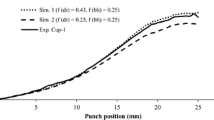Abstract
The numerical simulation of deep drawing processes is state of the art. Beside flow curves and yield locus, friction coefficients for blank-die contact are the most important, but often not exactly known, input parameters. This paper deals with the topic to calculate friction coefficients from Siebel’s formula for calculation of ideal maximum drawing force. Different modifications for special cases e.g. displaced blankholder or big die clearances are taken into account. The modified Siebel formula is used to determine friction coefficients for elevated temperatures up to 600 °C and different dry lubes. The calculated values for the friction coefficients are compared to values identified in numerical simulation.









Similar content being viewed by others
References
Lai M, Brun R (2007) Latest developments in sheet metal forming technologies and materials for automotive application: the use of ultra high strength steels at FIAT to reach weight reduction at sustainable costs. Key Eng Mater 344:1–8
UltraLight Steel Auto Body—Final Report. Information from: http://www.autosteel.org/~/media/Files/Autosteel/Programs/ULSAB/ulsab_final_report.pdf. 24 March 2014
Pitz M (2005) Laserunterstütztes Biegen höchstfester Mehrphasenstähle. In: Geiger M, Feldmann K (eds) Fertigungstechnik—Erlangen, vol 160. Meisenbach, Bamberg. ISSN 1431-6226, 53-60
Labudde T, Bleck W (2009) Formability characterisation of press hardened steels. In: Oldenburg M, Steinhoff K, Prakash B (eds) Proceedings of hot sheet metal forming of high performance steel, June 15–17, 2009, Luleå, Sweden, Luleå: Verlag wissenschaftliche Scripten, pp 127–135
Altan T, Tekkaya AE (2012) Sheet metal forming—fundamentals. ASM-International, USA
Dörr F, Liewald M (2012) Determination of flow factors for the semi-analytical prediction of friction coefficients. Prod Eng Res Dev 1:19–27
Severo V, Vilhena L, Silva PN, Dias JP, Becker D, Wagner S, Cavaleiro A (2009) Tribological behaviour of W–Ti–N coatings in semi-industrial strip-drawing tests. J Mater Process Technol 209:4662–4667
Littlewood M, Wallace JF (1964) The effect of surface finish and lubrication on the frictional variations involved in the sheet-metal-forming process. Sheet Metal Industries 41(452):925–930
Hu Z, Vollertsen F (2008) Modelling of friction with respect to size effects. Int J Mater Form 1:1231–1234
Vollertsen F, Hu Z (2008) Determination of size-dependent friction functions in sheet metal forming with respect to the distribution of the contact pressure. Prod Eng Res Dev 2:345–350
Wiegand H, Kloos KH (1960) Der Reibungs- und Schmierungsvorgang in der Kaltformgebung und Möglichkeiten seiner Messung. Werkstatt und Betrieb 4:181–187
Lange K (1990) Umformtechnik—Band 3: Blechbearbeitung. Springer, Berlin
Siebel E, Beisswänger H (1955) Tiefziehen. Hanser, München
Storoschew MW, Popow EA (1968) Grundlagen der Umformtechnik. Verlag Technik, Berlin
Geiger M, Merklein M, Lechler J (2008) Determination of tribological conditions within hot stamping. Prod Eng Res Dev 3(2):269–276
Beitz W, Grote K-H (2001) Taschenbuch für den Maschinenbau. Springer, Berlin
Doege E, Behrens B-E (2010) Handbuch Umformtechnik. Springer, Heidelberg
Acknowledgments
The presented results were achieved by investigations within the research Project DFG–ME2043/9–4. “Warm forming of high strength steel using granular material as a hydroforming medium” which is sponsored by the German Research Foundation (DFG).
Author information
Authors and Affiliations
Corresponding author
Rights and permissions
About this article
Cite this article
Grüner, M., Merklein, M. Determination of friction coefficients in deep drawing by modification of Siebel’s formula for calculation of ideal drawing force. Prod. Eng. Res. Devel. 8, 577–584 (2014). https://doi.org/10.1007/s11740-014-0551-1
Received:
Accepted:
Published:
Issue Date:
DOI: https://doi.org/10.1007/s11740-014-0551-1



